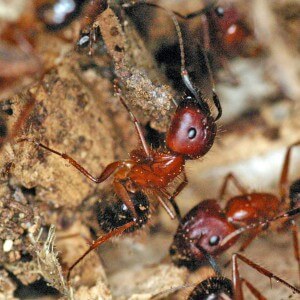Termites are one of the worst things you can ever get in your home. The amount of damage they can do astronomical. The expense of repair is overwhelming. However, a lot of the time they’re difficult to distinguish from carpenter ants.
What are carpenter ants?
Carpenter ants are bigger than normal ants. Workers have black, dark brown, red and black, yellow or red colouration. They range from 3.4 to 13 mm. In a colony there’s one wingless queen. Winged male and female workers will appear after the colony is mature. Carpenter ants are hard to distinguish. There’s many different species within North America. So, there’s no reliable way of identifying carpenter ants. Under a magnifying glass we can see the rounded profile of their thorax, heart-shaped head and circle of hairs on the rear.
Queens and reproductive males have forewings larger than their hind wings. They’re usually transparent or light brown. Winged ants commonly appear in the spring or fall. After females are fertilized they develop a nest and start a colony. Carpenter ant eggs are oval-shaped and cream coloured. Larvae are legless and during the pupal stage they transform into adults.
Carpenter ant damage.
Moist wood or structures make for perfect places for carpenter ants to call home. Most nests are found in decaying places such as windows, chimneys, sinks, doorframes or bath traps. Carpenter ant colonies can grow without you even knowing. They are hidden in wooden structures, weakening supportive material.
There’s two types of carpenter ant nests called parents and satellite colonies. Either can become problems within houses. Carpenter ants do not eat the wood. They strictly move shavings out creating long smooth corridors or galleries. The longer the infestation the more damage can be produced. The ants will continue to grow their colonies. Untreated it can cause major structural damage to your home.
What are termites?
There’s six common types of termites. Dampwood, drywood, formosan, subterranean, conehead and desert termites. Each have similar tendencies and often known as the “silent destroyer”. They can secretly and silently be in your home without showing any damage. All termites eat cellulose-based plant materials. Termites range from 6.35 to 12.7 mm in length. Queens and kings are much larger. Workers are soft-bodied and pale in colour. Winged termites, or reproductives, have two pairs of wings.
Wood makes up the diet of termites. They get nutrients from cellulose which is an organic fiber found in wood and plants. Each species prefers a different type of wood such as wet or dry. Although termites are small they can cause significant damage to homes consuming wooden structures.
Termite damage.
House foundations, furniture and shelves are all possible dinners for termites. Once the colony is fully constructed winged termites can be found by windows and doors. They’re attracted to light. When their work is done they move to different locations to start a new colony. This can be another place in your home. A lot of the time termite damage can go unnoticed. It develops behind enclosed areas.
Drywood termites live within the wood they consume creating elaborate tunnels behind walls or in furniture. They’re commonly mistaken with carpenter ants. The best distinction between the two are small piles of wood shaves expelled by carpenter ants. Termites will consume the wood.
Signs of carpenter ant infestation.
-
-
- Pile of wood shaving below entry points.
- Creaking or rustling sounds in wooden structures.
- Seeing winged ants from the ceiling.
- Large galleries behind walls or in structures.
-
St. Catharine’s ant removal.
Carpenter ant infestation can get out of control. Much of the destruction is done behind walls or within structures. If you discover any evidence of infestation contact Truly Nolen Pest Control.
